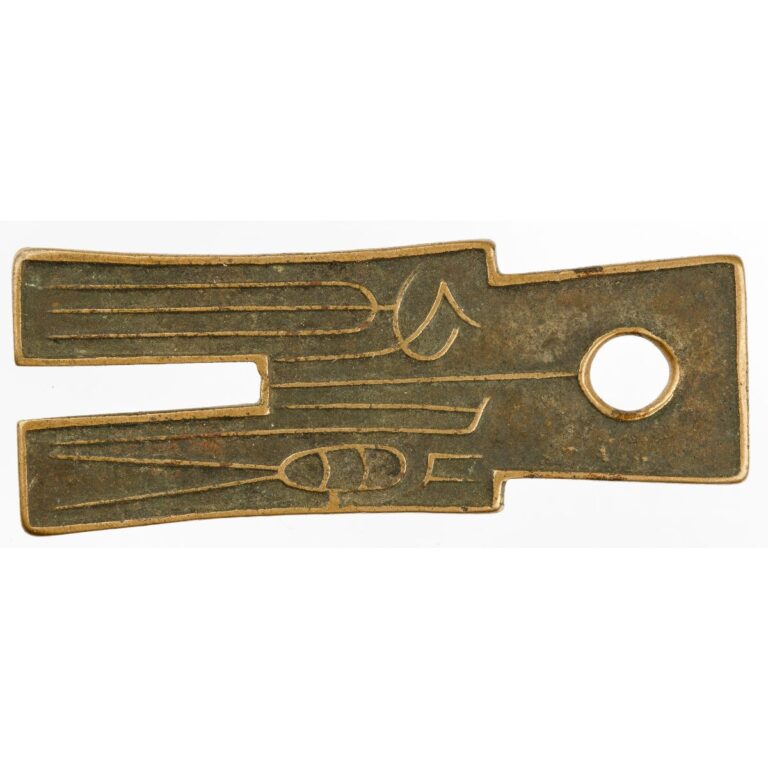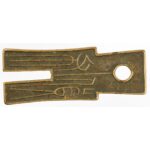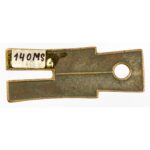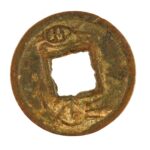Coin in the shape of a shovel
This coin is a numismatic rarity, dating from the brief interregnum of Wang Mang 王莽 (45–23 B.C.), who after the fall of the Western Han Dynasty (206 B.C.–A.D. 8) briefly ruled over its territory. He was the nephew of Empress Wang 王 (71 B.C.–A.D. 13, widow of Emperor Hanyuan 漢元 (75–33 B.C.)), and was appointed regent to the barely two-year-old Emperor Ruzi 孺子 (5–25) in year 7. In year 9, he ascended the throne, founding the short-lived Xin 新 Dynasty (9–23). While some see him as a great visionary and reformer who took land away from large landowners and influential families, nationalised it, and distributed it to peasants, others characterise him primarily as a usurper and autocrat. During his short reign, however, he carried out a series of far-reaching and highly ambitious social, political, and economic reforms, including monetary ones. He revived several coin designs from the Warring States Period (475–221 B.C.). The wuzhu 五銖 coins (five ... more
This coin is a numismatic rarity, dating from the brief interregnum of Wang Mang 王莽 (45–23 B.C.), who after the fall of the Western Han Dynasty (206 B.C.–A.D. 8) briefly ruled over its territory. He was the nephew of Empress Wang 王 (71 B.C.–A.D. 13, widow of Emperor Hanyuan 漢元 (75–33 B.C.)), and was appointed regent to the barely two-year-old Emperor Ruzi 孺子 (5–25) in year 7. In year 9, he ascended the throne, founding the short-lived Xin 新 Dynasty (9–23). While some see him as a great visionary and reformer who took land away from large landowners and influential families, nationalised it, and distributed it to peasants, others characterise him primarily as a usurper and autocrat. During his short reign, however, he carried out a series of far-reaching and highly ambitious social, political, and economic reforms, including monetary ones. He revived several coin designs from the Warring States Period (475–221 B.C.). The wuzhu 五銖 coins (five zhu 銖 or 3.25 grams) from the preceding Qin (221–206 B.C.) and Western Han dynasties remained in use as the basic monetary unit. In addition to these he also issued large coins daquan wushi 大泉五十, meaning “large coin worth fifty,” which were worth 50 wuzhu. He also revived several coin designs from the Warring States Period (475–221 B.C.). His most famous coins are shaped like a shovel (bubi 布幣) and a knife (daobi 刀幣), more reminiscent of a key.
This large spade-shaped coin is another of Wang Mang’s innovations, issued between 10 and 14. It is inscribed, with elaborately engraved seal script (zhuanshu 篆書) characters: dabu heng qian 大布衡千, meaning “large shovel, weight one thousand”. Its value was equivalent to five thousand units. It is thus a higher-value coin that is highly sought after in numismatics today because of its rarity and high-quality workmanship. In practice, Wang Mang’s system of minting money did not catch on. His failed reforms triggered major peasant uprisings that led to his overthrow in A.D. 23 when rebels captured the capital Chang’an 長安 (present-day Xi’an). (MG)







































Do you have a comment or additional information about the subject?